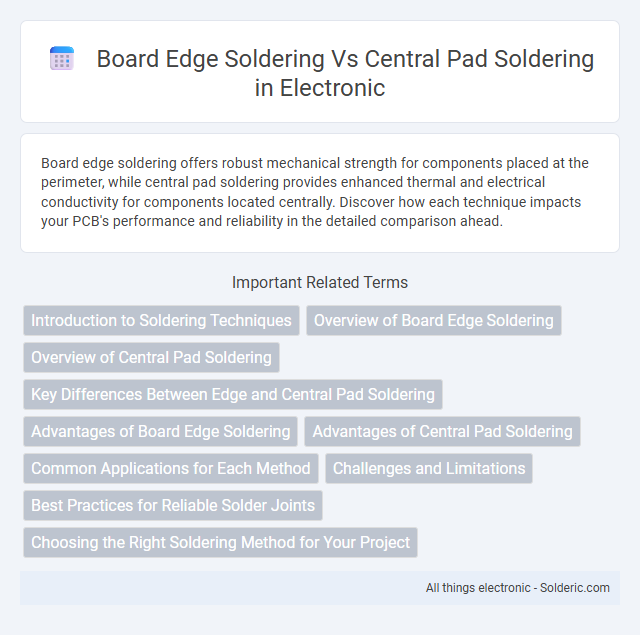Board edge soldering offers robust mechanical strength for components placed at the perimeter, while central pad soldering provides enhanced thermal and electrical conductivity for components located centrally. Discover how each technique impacts your PCB's performance and reliability in the detailed comparison ahead.
Comparison Table
| Feature | Board Edge Soldering | Central Pad Soldering |
|---|---|---|
| Soldering Location | At the edge of the PCB | On central pad(s) within the PCB |
| Mechanical Strength | Moderate; may suffer stress at edges | High; central pads offer better support |
| Thermal Conductivity | Lower; edge area limits heat dissipation | Higher; central region enhances heat spread |
| Signal Integrity | Potential interference due to edge proximity | Improved; central placement reduces noise |
| Assembly Complexity | Simpler; easier manual access | More complex; may require precision tooling |
| Space Utilization | Consumes board edge space | Utilizes internal board area efficiently |
| Applications | Ideal for edge connectors and quick replacements | Suitable for high-reliability and high-density circuits |
Introduction to Soldering Techniques
Board edge soldering involves attaching components at the perimeter of the PCB, enhancing mechanical stability and often used for edge connectors, while central pad soldering connects components directly on the main PCB surface, optimizing electrical performance and heat dissipation. Each soldering technique impacts signal integrity, assembly complexity, and repairability, with board edge soldering providing easier access for testing and replacement. Understanding these methods allows you to select the best approach for your PCB design requirements and manufacturing process.
Overview of Board Edge Soldering
Board edge soldering involves attaching components directly to the perimeter of a printed circuit board (PCB), facilitating electrical connections through edge contacts or pads. This technique is commonly used for connectors and modules requiring easy insertion and removal, optimizing space on the PCB. Your design can benefit from enhanced signal integrity and mechanical stability by leveraging board edge soldering in appropriate applications.
Overview of Central Pad Soldering
Central pad soldering offers enhanced thermal management by concentrating heat dissipation through a single, centralized contact point on the PCB. This method improves mechanical stability and electrical performance, reducing the risk of solder joint failure compared to board edge soldering. Your electronic designs benefit from increased reliability and efficient heat transfer with central pad soldering techniques.
Key Differences Between Edge and Central Pad Soldering
Board edge soldering involves connecting components along the perimeter of the PCB, providing easier access for testing and repair, whereas central pad soldering places pads within the board's interior, allowing for higher component density and improved signal integrity. Edge soldering is often used for connectors and slots, offering robust mechanical support, while central pad soldering suits surface-mount components requiring precise thermal control. Your choice depends on design priorities such as assembly complexity, thermal management, and electrical performance requirements.
Advantages of Board Edge Soldering
Board edge soldering offers enhanced mechanical stability by providing a robust connection along the PCB perimeter, reducing stress on individual components. It improves thermal dissipation, benefiting high-power applications by efficiently transferring heat away from critical areas. You gain easier inspection and rework capabilities, as the accessible solder joints along the edges simplify quality control and repair processes.
Advantages of Central Pad Soldering
Central pad soldering offers superior thermal management by providing a larger, more uniform heat dissipation area compared to board edge soldering. This method enhances mechanical stability, reducing the risk of solder joint failure and improving overall reliability in high-vibration environments. Your electronic assemblies benefit from improved electrical performance and easier automated assembly processes with central pad soldering.
Common Applications for Each Method
Board edge soldering is commonly used in applications requiring strong mechanical support and reliable electrical connections for components like edge connectors, card slots, and memory modules in computers and telecommunications equipment. Central pad soldering is typically employed for surface-mount devices (SMDs) such as integrated circuits, resistors, and capacitors on printed circuit boards (PCBs) in consumer electronics, automotive systems, and medical devices. Each method optimizes thermal management and signal integrity based on component placement and function within electronic assemblies.
Challenges and Limitations
Board edge soldering faces challenges like limited mechanical strength and higher risk of solder bridging due to narrow contact areas, impacting long-term reliability. Central pad soldering offers improved heat dissipation and stronger electrical connections but requires precise alignment and can complicate rework processes. Your choice must consider manufacturing tolerances and the specific application's thermal and mechanical demands.
Best Practices for Reliable Solder Joints
Board edge soldering requires precise alignment and controlled heat application to prevent solder bridges and ensure electrical connectivity along the PCB perimeter, while central pad soldering demands optimal pad design and sufficient solder volume for secure component attachment. Using flux-rich solder and maintaining consistent temperature profiles are critical for both methods to achieve reliable joints and prevent thermal damage. Implementing automated inspection techniques such as X-ray or AOI enhances joint quality verification and reduces the risk of solder defects.
Choosing the Right Soldering Method for Your Project
Board edge soldering offers a reliable connection for components that require mechanical support and easy access to edges, making it ideal for connectors and high-current applications. Central pad soldering provides enhanced thermal dissipation and electrical performance, especially for ICs and components with heat-sensitive operation. Evaluating your project's electrical, thermal, and mechanical requirements ensures you select the optimal soldering method for durability and performance.
Board edge soldering vs central pad soldering Infographic

 solderic.com
solderic.com